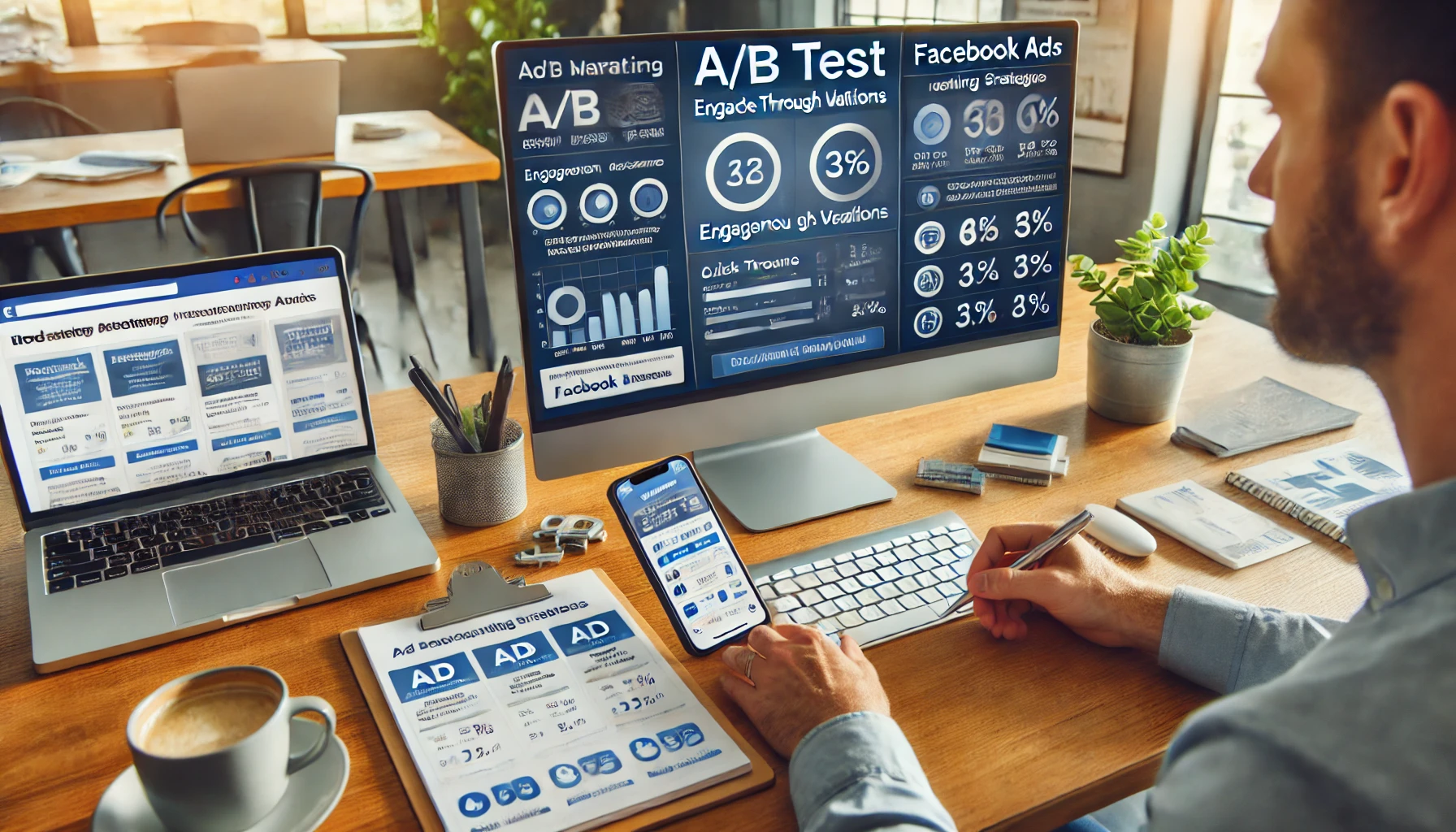A/B testing (also known as split testing) is one of the most powerful tools available for Facebook advertisers. It allows you to compare different versions of your ads to determine which one performs best. Without A/B testing, you may be wasting money on ineffective ads, missing opportunities to improve conversions, and failing to maximize your return on investment (ROI).
In this article, we’ll explore why A/B testing is essential, what elements to test, and how to implement it effectively in your Facebook ad campaigns.
1. What Is A/B Testing in Facebook Ads?
A/B testing is a data-driven method that helps advertisers compare two or more variations of an ad to determine which performs better.
For example, you might run:
- Ad A: A static image with a bold call-to-action (CTA).
- Ad B: A video ad with a storytelling approach.
After running both ads for a specific period, you can analyze which one generates higher engagement, lower cost per click (CPC), and better conversions.
2. Why A/B Testing Is Crucial for Facebook Ads
✅ Eliminates Guesswork – Instead of assuming what works, you get real data on which ads drive results.
✅ Reduces Ad Spend Waste – Poor-performing ads can be identified and paused quickly.
✅ Increases Conversion Rates – Testing different ad elements helps find the best combination for higher conversions.
✅ Improves Audience Targeting – You can test different audiences to see which responds best to your ads.
A/B testing helps you make strategic, data-backed decisions that maximize ad performance and profitability.
3. What Elements Should You A/B Test?
To get the best results, you need to test one variable at a time. Here are the most important elements to A/B test in your Facebook Ads:
🎯 1. Ad Creatives
- Images vs. Videos: Test whether static images or videos perform better.
- Different Image Styles: Bright vs. dark backgrounds, product-focused vs. lifestyle images.
- Carousel Ads vs. Single Image Ads: Some products or services perform better in carousel formats.
✍️ 2. Ad Copy & Headlines
- Headline Variations: Try short and direct headlines vs. longer, descriptive ones.
- Ad Copy Length: Test short, punchy text vs. detailed storytelling approaches.
- Tone & Style: Formal vs. casual language.
🎯 3. Call-to-Action (CTA)
- Different CTA Buttons: “Learn More” vs. “Sign Up” vs. “Shop Now.”
- CTA Placement: Within the first sentence vs. at the end of the ad copy.
📌 4. Audience Targeting
- Lookalike Audiences vs. Interest-Based Audiences: Which audience brings better conversions?
- Broad Targeting vs. Narrow Targeting: Do you get better results by keeping it broad or being highly specific?
- Demographics: Test different age groups, gender, locations, and behaviors.
🎯 5. Ad Placements
- Facebook Feed vs. Instagram Feed: Where does your audience engage the most?
- Mobile vs. Desktop Ads: Some ads perform better on mobile, while others work better on desktop.
- Stories vs. News Feed Ads: Test if your audience interacts more with stories or feed posts.
4. How to Set Up an A/B Test in Facebook Ads Manager
Facebook makes A/B testing simple through the Experiments tool in Ads Manager. Here’s a step-by-step guide to setting up your first test:
Step 1: Create a New A/B Test
- Go to Facebook Ads Manager and click on Experiments under the “Measure & Report” section.
- Select A/B Test and choose whether to test an existing campaign or create a new one.
Step 2: Choose the Variable to Test
- Select one variable to test (e.g., audience, ad copy, image).
- Facebook will duplicate your existing ad and change only that one variable.
Step 3: Define the Budget and Duration
- A/B tests should run for at least 7 days to collect enough data.
- Set a budget that allows both variations to reach a meaningful number of users.
Step 4: Launch the Test and Monitor Performance
- Facebook will track performance and determine a winner based on your chosen metric (e.g., click-through rate, conversions).
- Once the test is complete, scale the winning ad and stop running the losing variation.
5. Analyzing A/B Test Results
After running an A/B test, check the following key metrics:
📊 Click-Through Rate (CTR): Which ad gets more clicks?
📊 Cost Per Click (CPC): Which variation gets cheaper clicks?
📊 Conversion Rate: Which ad leads to more sign-ups or purchases?
📊 Cost Per Acquisition (CPA): Which version converts users at the lowest cost?
If the results are unclear, consider running another test with a different variable.
6. Common A/B Testing Mistakes to Avoid
🚫 Testing Too Many Variables at Once – This makes it hard to determine what caused a performance change.
🚫 Running Tests for Too Short a Time – Tests should run at least 7 days to gather enough data.
🚫 Not Defining Clear Goals – Always define what success looks like before running the test (e.g., lower CPC, higher conversions).
🚫 Stopping the Test Too Early – If results fluctuate in the first few days, give the test more time to stabilize.
7. Scaling Your Ads After a Successful A/B Test
Once you identify a winning ad variation, scale it properly by:
- Increasing the budget gradually (no more than 20-30% per day).
- Expanding to Lookalike Audiences based on your highest-converting customers.
- Duplicating the winning ad and testing new placements or creatives.
By continuously testing and refining your ads, you ensure that your campaigns remain profitable and competitive.
Final Thoughts
A/B testing is an essential part of Facebook advertising success. It allows you to make data-driven decisions, reduce wasted ad spend, and optimize campaigns for the highest ROI.
By testing different ad elements, analyzing results, and scaling winning variations, you can dramatically improve the performance of your Facebook Ads.
Start A/B testing today and watch your ad results improve over time! 🚀
